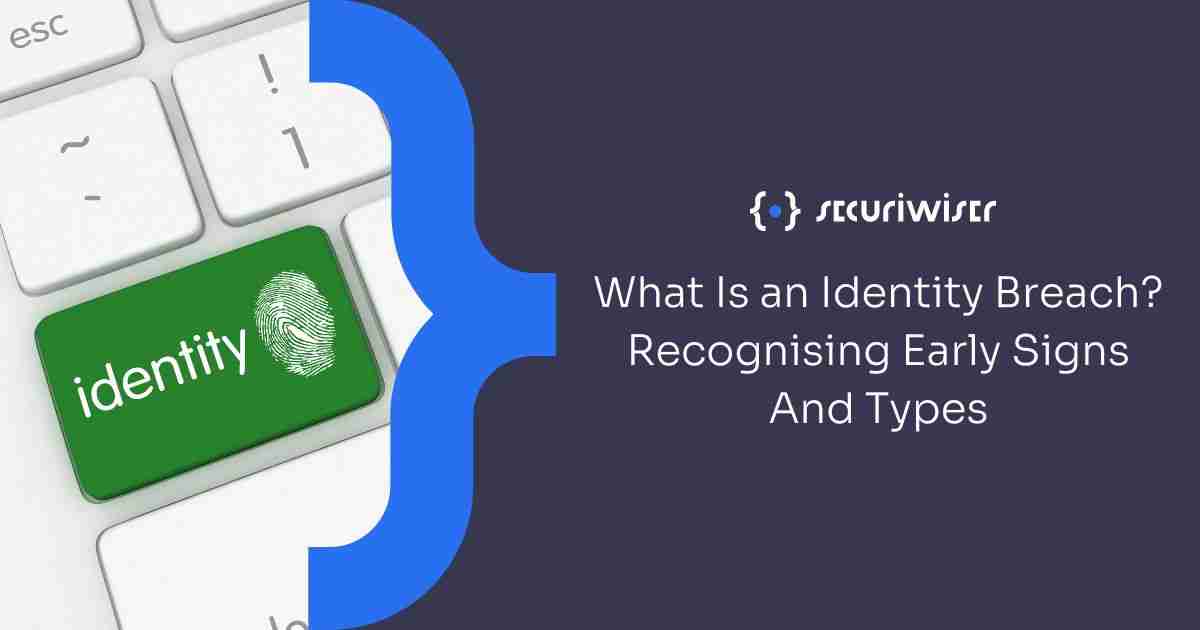What Is an Identity Breach? Recognising Early Signs And Types
Blog / What Is an Identity Breach? Recognising Early Signs And Types
4 MIN READ


What Is an Identity Breach?
An identity breach is an incident in which a person’s identity is stolen or exposed. It is also known as identity theft and occurs when someone gains unauthorised access to an individual's personal information and uses it for fraudulent purposes. Identity breaches can have serious consequences, including financial loss, reputational damage, emotional distress, and even the risk of physical harm.
Identity Fraud vs. Identity Breach Vs. Identity Theft
Some of the most frequent terms that are used in this field are identity fraud, identity breach, and identity theft. These terms are interchangeable and are often used to describe similar types of crimes, but they can have slightly different meanings depending on the specific context in which they are used.
Identity Fraud
Identity fraud refers to the use of stolen or falsified personal information to commit a crime or to deceive someone. Using a stolen identity to obtain credit, obtaining medical treatment, or committing a crime are examples of identity fraud.
Identity Breach
Identity breach refers to unauthorised access to an individual's personal information. Examples of this may be anything from stealing someone's login credentials to gaining access to their personal records.
Identity Theft
Identity theft happens when someone uses another person's personal information, such as their name, address, or credit card numbers, for fraudulent purposes. This can include making purchases or obtaining loans in someone else's name.
Common types and methods of Identity Breaches
Knowing the different types of identity breaches and signs of an identity breach could help organisations protect themselves from such threats.
Financial identity
Financial identity theft is the most common type of identity breach and involves the unauthorised use of an individual's personal information, such as their name, address, and credit card numbers, to make purchases or obtain loans. This type of identity breach can result in financial loss and damage to an individual's credit score.
Criminal Identity
Criminal identity theft occurs when someone uses another person's identity when committing a crime. This can result in the victim being wrongly accused and potentially facing criminal charges.
Medical Identity
Medical identity theft involves the unauthorised use of an individual's personal and medical information, such as their health insurance information, to obtain medical treatment or prescription drugs. This type of identity breach can result in incorrect medical records, incorrect treatment, and financial loss.
Data Breaches
A data breach occurs when hackers gain access to an organisation’s computer network and steal sensitive information. This could consist of credit card numbers, Social Security numbers, and other personal data.
Malware Attacks
Malware attacks occur when malicious software is installed on a computer or device. This malicious software can be used to steal personal information, including passwords and credit card information.
Social Engineering
Social engineering involves using deception to gain access to personal information. This can be done through fake emails, websites, and phone calls.
Phishing Attacks
Phishing attacks involve sending fraudulent emails or messages that appear to come from legitimate sources. These emails or messages contain malicious links or attachments that can install malware on your computer or device.
Common signs of an Identity Breach
There are several signs that victims of an identity breach can be on the lookout for. These include:
• Unfamiliar charges on credit card statements
• Unexpected credit card bills or loans
• Denial of credit or being offered credit at a higher interest rate
• Emails or letters from unfamiliar businesses or creditors
• Being contacted by debt collectors for unfamiliar debts
• Unauthorised charges on your bank statement/account
• Unsolicited emails, letters, or phone calls from unknown people or companies
• Missing mail or mail from companies you don’t recognise
• Unusual activity on your social media accounts, such as messages from unknown people or posts you didn’t write
How to protect yourself from Identity Breach
If anyone suspects that they could be the victim of an identity breach, several steps can be taken to protect themselves:
• Place a fraud alert on credit reports
• Monitor your credit reports and billing statements for unfamiliar activity
• Close any compromised accounts till checks are made
• Use strong and unique passwords for all your accounts
• Enable two-factor authentication
• Install security software, such as anti-virus, anti-malware, and firewall software
• Be aware of malicious activities
• Ask questions before you share your personal information
What to do if my identity has been stolen
If you suspect that your identity has been stolen, it is important to act quickly to minimise the damage and to protect yourself. Here are some steps to take if you believe your identity has been stolen:
Contact your bank
Contact your bank immediately if you suspect that your bank accounts have been compromised, it is important to contact your bank as soon as possible. Your bank will be able to help you to close any compromised accounts and to protect any remaining accounts from further fraudulent activity.
Contact the police
If you believe that you have been the victim of identity theft, it is important to report the crime to the police. The police will be able to help you to gather evidence and to identify the perpetrator.
Contact the credit reference agencies
In the UK, there are three main credit reference agencies: Equifax, Experian, and TransUnion. It is important to contact these agencies and place a fraud alert on your credit report. This will help to prevent further fraudulent activity in your name.
Change your login credentials
If you believe that your log-in credentials have been compromised, it is important to change your passwords and security questions for all of your accounts. Use strong, unique passwords and enable two-factor authentication wherever possible.
Monitor your accounts
It is important to regularly review all of your accounts, including your bank accounts, credit card statements, and credit reports, to identify any unfamiliar activity.
By understanding what an identity breach is, recognising the signs of an identity breach, and taking steps to protect yourself, you can help reduce the risk of becoming a victim of identity theft. Remember to always use strong and unique passwords, enable two-factor authentication, encrypt your data, and install security software. Doing so can help keep your information secure and protect you from potential data breaches.
Sign up for a free Securwiser account now and protect your organisation from an identity breach. Click the link to create your account and get started today!
Previous Article
What is Vendor Risk Management?How secure is
your business?
Blog categories
How secure is
your business?